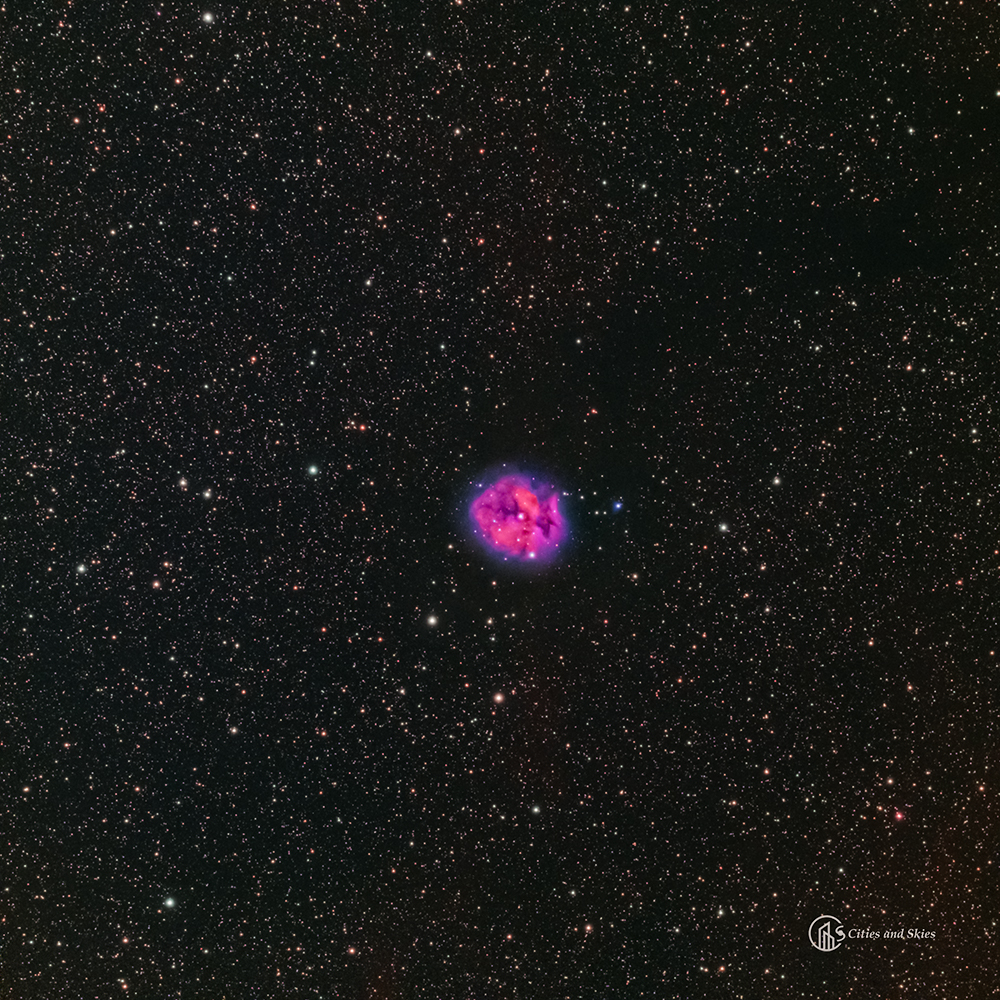The Cocoon Nebula is a rare kind of phenomenon, as we will see below. Emission nebulae are often related to sites of massive star formation in the Milky Way. They appear in various forms, like the turbulent gas flows of the Orion Nebula, or the phenomenal Elephant’s Trunk Nebula with its bright-rimmed dark clouds. Dust in these dark clouds plays an important part in star formation. While gases glow around the hottest young stars, the dust may reflect light as well, producing a spectacular show like in the Iris Nebula. But amidst this variety, there are still particular cases that are just unique.
A Cluster of Stars and the Cocoon Nebula (IC 5146)
Within the Cocoon Nebula, there is a cluster of young stars of about a million years old. In the center lies the brightest and hottest of these, BD +46°3474, an early B-type star that is illuminating the nebula. The central star created a large cavity, a place where stars are in the making. The nebula and cluster are located at the rim of a large, dark molecular cloud complex. This can be traced to up and to the right in our image. The gas and dust flow through a funnel-shaped volume in our direction, producing a compact and circular appearance to the cloud, and opening up a window to the star formation site.
Cosmic filaments
In fact, star formation is ongoing all along in the dark cloud complex, also known as Barnard 168. They are hidden to our eyes by dust, but they are visible to infrared and X-ray telescopes. The ESA’s Herschel Space Observatory produced a spectacular image of the whole region, showing large filaments of gas. These filaments are produced in sonic shock waves in the interstellar medium. The shock waves may be produced by for example supernova explosions. They compress the gas and magnetic fields, which eventually leads to forming new stars in the densest parts of these filaments.
Massive star formation and the Cocoon Nebula
For a long time, it was not clear to astronomers whether normal stars form the same way as the more massive ones. One of these models is a direct collapse of gas to dense stellar cores in a fragmenting molecular cloud. However, the observed rate at which gas falls to massive protostars is just not enough to accumulate all the material that makes up these stars, during their short lifetime. The other model is Competitive Accretion when gas is accumulated chaotically from a wide region. In this case, one may expect that massive stars are formed in stellar clusters, just like we see in the Cocoon Nebula.
The role of the magnetic fields
The role of magnetic fields in distributing the stellar masses inside star-forming regions has been debated as well. In the filaments of the larger star-forming region around the Cocoon Nebula, a well-ordered magnetic field was observed, preferring strong magnetic field star formation models. Still, other studies indicate the effect of magnetic fields are more subtle, mainly affecting the feedback of star formation on its surroundings, in the forms of outflows, supernovae, and so forth.
Further detailed studies of the Cocoon Nebula and similar star formation sites will probably help answer these questions. We are particularly eager to see images made by NASA’s James Webb Space Telescope, which was launched recently.
References
Herbig & Dahm 2002, AJ, 123, 304
Arzoumanian et al. 2011, A&A, 529, L6
Wang et al. 2020, ApJ, 888, 13
Tan et al. 2014, Protostars and Planets VI, University of Arizona Press, Tucson, 149
Krumholz & Federrath 2019, Frontiers in Astronomy and Space Sciences, 6, 7
Wikipedia
Observing log
The first two nights used a broadband filter (9, 10 June; 30x300s both nights, gain 101, -10 degrees). It was rather warm during the day. The summer nights are not really dark in the Netherlands, which is not ideal for broadband shooting. Did two additional nights with a narrowband filter (12, 13 June; 30x300s both nights, gain 240, -10 degrees), which were a bit cooler.
Total exposure time: 120 x 5 min (10h).
Telescope: William Optics GT81, f/5.9, with Flattener 6AIII 0.8x
Camera: ZWO ASI533MC-P
Guidescope: WO Uniguide 50/200 with ASI120MMmini
Mount & control: iOptron CEM40, ASIair Pro
Filters: Optolong L-Pro, Optolong L-eXtreme
Software: Astro Pixel Processor, Photoshop
